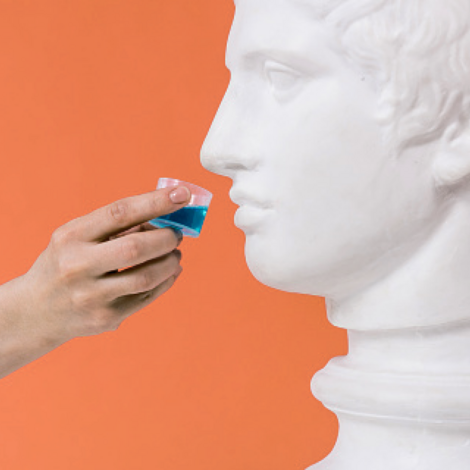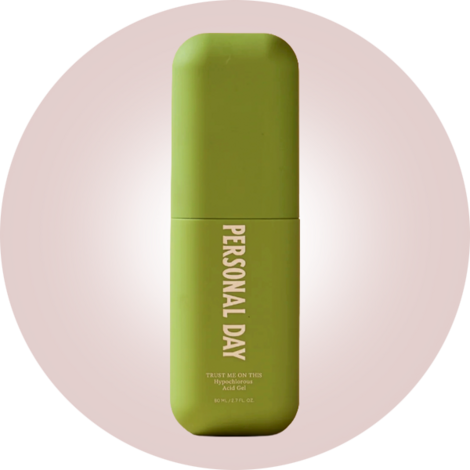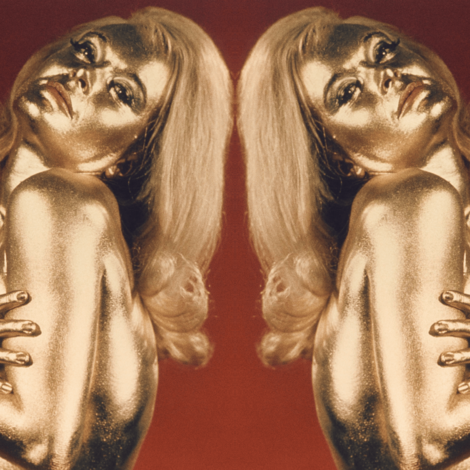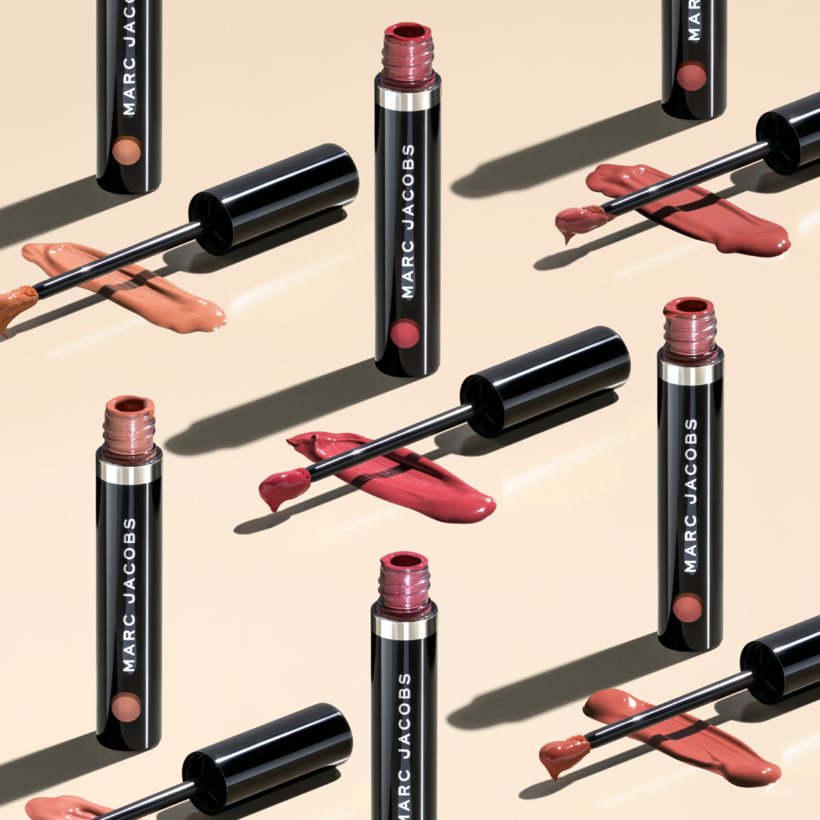The eyeliners were an inevitability. For nearly four decades, Marc Jacobs has presided over New York’s fashion world—less like a king, and more like a scientist who lives on the hill overlooking town—slicing and fusing disparate styles of dress to the tune of his own mad genius. A little haute couture, a little jolie-laide. A little grunge, a little punk. Louis Vuitton used to be a leather goods company until Marc was asked to make it a fashion company. His artist collaborations with Takashi Murakami, Stephen Sprouse, Richard Prince, and others turned handbags into collectibles. His fragrance, Daisy, has been a best-seller more or less since the day it was born, in 2007. His muses include Sofia Coppola, Kate Moss, and Miss Piggy. The world of cosmetics was not just a natural fit for Marc, but a manifest destiny—the final frontier of a woman’s wardrobe, or maybe just a new laboratory to play in.
When Marc Jacobs Beauty launched with LVMH and Sephora’s beauty incubator, Kendo, in 2013, Jacobs had endeavored to create a makeup line that had what he called “the right amount of wrong.” He cast Jessica Lange in a 2014 campaign, and promoted the products himself on his social-media channels with elaborately painted selfies and Instagram Lives. For Jacobs, cosmetics were a piece of the whole image—he seemed to think of makeup as an accessory, like a handbag.
“It was very personal to Marc,” a source close to Jacobs told me. When the photographer Raymond Meier helped articulate the look of Marc’s beauty in its ads, the designer was beside him in the studio. “He directs it and fine-tunes it, and it really becomes Marc Jacobs,” Meier told me. Many of the ads arranged still lifes in endlessly reproducible compacts or lipsticks with a clean, endless glamour that has itself been endlessly reproduced by other makeup companies. “On every mood board, for the longest time, there was Marc Jacobs Beauty,” he says, sounding almost grief-stricken.
Someone who had worked on the Kendo side echoed this impression: “Kendo was all about quality, and so was Marc,” they said. “He was very invested.” He often discussed pigments in the language of textiles, which he spoke more fluently than the language of cosmetic chemistry. Blush wasn’t brushed onto cheekbones but draped there. The brand’s best-selling mascara, Velvet Noir, was inspired by an apocryphal tale from Jacobs’s childhood of watching his mother shave a velvet ribbon into downy flakes that she’d press into her lashes. Jacobs didn’t want natural-looking makeup—”That’s a little lazy,” he told WWD. Marc Jacobs Beauty wasn’t no-makeup makeup; it was makeup-makeup makeup.
Each product was also fabulous. To say everybody loved them only slightly verges on hyperbole. Praise blooms everywhere, even in the frankest corridors of online product tribunals. For the Highliners, especially—gel eye pencils with the true and perfect approximate texture of oil pastel crayons. Also the Eye-conic palettes, sized like rearview mirrors, and the O!Mega bronzers, like canapé plates.
Diane Kendal, the makeup artist who helped develop the line, heard from all over how much people liked the palettes. Daphne Guinness painted her eyelids in shades of Eye-conic. Emily Ratajkowski used Marc’s eye pencil; Zazie Beetz applied the Shameless foundation. Aubrey Plaza told Into the Gloss that her Highliner in Blacquer protects her from evil: “I was like, ‘I just need to put this in my car because you never know.’”
And the Under(cover) Perfecting Coconut Face Primer? I am not ashamed of loving it conspicuously, and of draining more than a few bottles of the stuff in the year 2016 working at a beauty blog, to the extent of receiving it as a gift many times, literally being a magnet for the stuff, for a large part of that year. Also, everything was vegan and cruelty-free.
The world of cosmetics was not just a natural fit for Marc, but a manifest destiny.
And then it ended. Not with a Bang! (by Marc Jacobs cologne, 2010), but with absolutely nothing. In 2021, fans of the brand noticed deep discounts on every product. By the end of the year, fashion-news Web sites and beauty bloggers had reported that Marc Jacobs Beauty was being discontinued, though to this day no official party—not LVMH, nor Marc, nor Kendo—has confirmed the line’s fate. The secrecy surrounding the brand’s quiet death almost lends it an air of conspiracy—was there bad blood or money troubles, or did this have to do with the time Jacobs accidentally posted an ass pic to Instagram?
In lieu of official communications, we are left with nothing but a wide and fertile field in which to sow seeds of speculation. Let’s see what grows—shall we?
EXHIBIT A
The Missing Makeup
Trying to coax information out of Kendo, the beauty-brand incubator within the luxury conglomerate LVMH Moët Hennessy Louis Vuitton, is a little like trying to squeeze milk from a boulder. The company guards facts and figures about its internal machinations, many of which involve prestige cosmetics, with Area 51–level discretion. I reached out to Tara Loftis, Kendo’s global vice president of brand marketing and public relations, as well as several other Kendo executives, but none responded to my inquiries, which were all riffs on a question of undeniable meaninglessness for all but a (gorgeously painted) sliver of human civilization: What happened to Marc Jacobs Beauty?

Kendo, named for the company’s “Can Do” ethos, came from Sephora Originals, which was established in 2010 with the aim of conceiving, birthing, and nurturing beauty brands from infancy to adulthood and profitability. Within this metaphorical framework, it’s possible to imagine a natural graduation point for brands like Marc Jacobs Beauty. A cap and a gown, a party in a ballroom at the Marriott, Mom’s station wagon piled high with O!Mega Bronzers and Re(Marc)able Foundations bound for beauty counters from Dallas to Dubai to the Dufry shops. Instead, it felt like attending a commencement ceremony only to find the graduating class missing, because they’re down the street at TJ Maxx next to the bath bombs.
Reddit was the first to notice. On r/MakeupAddiction, an April 2021 thread wondered aloud: What is up with Marc Jacobs Beauty? By that point, the line had been heavily discounted on its own retail Web site, as well as at Sephora, which had been acquired by LVMH in 1997 and served as a flagship retailer for Kendo’s beauty brands. One month later, on r/BeautyGuruChatter, a user posted a short but devastating chat transcript with a Sephora beauty adviser named Keeley. They had asked where Marc went, and Keeley answered: “So unfortunately, Marc Jacobs has decided to close up shop on their cosmetic line.” At the end, she added a deflated-looking emoji.
The speculation took on shades of panic. Shortly after the Sephora chat was posted, inquiries spilled into the inbox of Kirbie Johnson, a beauty writer and co-host of the Gloss Angeles podcast, who reached out to a press contact at Kendo. “The official response was, ‘We are very proud of Marc Jacobs Beauty and we are happy to assure you the brand is not closing.’ And then they were never heard from again,” Johnson said. “It almost felt like there was a death and everybody just ignored it.”
To date, neither LVMH, nor Kendo, nor Marc Jacobs International has issued an official statement on Marc Jacobs Beauty, instead disseminating approved talking points to reporters and bloggers. In May 2021 from @trendmood1, an anonymous Instagram account that frequently breaks beauty news: “The brand is exploring opportunities with a new partner. The brand is not being discontinued and currently in the process of strategizing the best way to reach their global customer going forward.” Loftis liked the post.
Last week, @trendmood1 posted an update: Another beauty blogger noticed an empty landing page for the line on Net-a-Porter’s website, prompting the Marc-hungry masses to surge back into comment sections and Reddit threads, but it turned out to be an optimistic misreport. “We do not have plans to relaunch MJB on site,” a spokesperson for Net-a-Porter confirmed. The page has been replaced with a standard error message: “Sorry, we can’t find what you’re looking for.”
EXHIBIT B
Shifting Fortunes
It was a family affair. When LVMH’s Sephora formed its own beauty incubator, Sephora Originals, the aim was plainly and concisely described in the name: create original beauty-product lines for sale exclusively at Sephora. Early projects mostly took the form of partnerships with existing companies—Sephora x OPI nail polishes, or Sephora x Sanrio Hello Kitty compacts—or celebrity-adjacent professionals like Katherine Von Drachenburg, commonly known as Kat Von D, whose stand-alone makeup range was so successful that it eclipsed its founder, a tattoo artist with a flair for controversy. Von Drachenburg sold her shares in the company, which rebranded to KVD Vegan Beauty, in 2020.
Marc Jacobs, already sitting pretty in LVMH’s portfolio with a color-cosmetics-collection-sized hole in its world of offerings, perhaps seemed like a sound gamble. The brand had already found success in the beauty market with its lucrative Coty-licensed perfumes. (In 2019, the Daisy family of fragrances alone was estimated to have brought in some $300 million in revenue.)

Around the time of the makeup line’s conception, Jacobs’s place in the fashion firmament was shifting. In 2010, he was one of Time’s “most influential people.” A year later: “With the exception of his fragrances, he is less on people’s radar,” a youth-marketing consultant told The New York Times, in a piece about Jacobs titled The Survivor. In 2013, Jacobs left his post at Louis Vuitton in part to focus more on his namesake brand—a move that, if nothing else, indicated that his focus may have at least in part been lacking. The Marc by Marc Jacobs diffusion line was discontinued a few years later. In January 2017, LVMH’s C.E.O. and chairman, Bernard Arnault, discussed the embattled fashion brand on an earnings call: “I’m more concerned about Marc Jacobs than the U.S. president.”
Marc Jacobs Beauty launched in 2013, with a vanity of color cosmetics in a wardrobe of textures—vinyl lip paints, plush pressed shadows, blackest-black gel crayons. It is easy to imagine that, like other projects at this time, the makeup line simply missed the Marc (sorry!). But Marc Jacobs Beauty was expected to generate more than $20 million in its first year of business, and grow from there.
“I’m more concerned about Marc Jacobs than the U.S. president.”
Some former Kendo insiders suggested that the original licensing contract could not have scaled beyond a certain incubation point. A source who previously worked at Kendo invoked a similar situation with the Elizabeth and James fragrances, which were Sephora best-sellers before Kendo returned the fragrance license to Elizabeth and James. Bite Beauty also bit the dust—the 2014 Kendo acquisition relaunched in 2020 with new formulas and packaging, only to shutter in 2022.
In 2022, the Marc Jacobs Beauty license expired and was returned to Marc Jacobs International to do with as the company pleased. In this light, the line’s discontinuation looks less like an untimely death and more like an unfortunate divorce between once-smitten lovers.
“Kendo has been an amazing brand incubator,” the source told me. “[Marc] is not necessarily the first brand that this happened to. Just probably the largest. And most impactful.”
Exhibit C
The Pop Paint Wars
2017. Marc Jacobs Beauty was four years old and toddling along to the tune of an estimated tens of millions of dollars per year. Spring brought Technicolor mascaras and a campaign starring Kaia Gerber. LVMH reported more growth.
And then, a surprise: Kendo was expecting again. It would give birth in the fall. Rihanna was the egg donor.
Fenty Beauty was born with 91 bouncing and beautiful products, this time in Sephora stores around the world simultaneously. “The first ever global beauty launch in history,” touted its parent company, jubilant with new life.
The line’s hero product, the Pro Filt’r Foundation, was immediately acclaimed for its 40-shade range. Not because Fenty was the first major makeup brand to introduce a truly exhaustive library of skin tones—MAC, Lancôme, and Make Up For Ever already had—but because it was the first major makeup brand to introduce foundation as a standard for beauty inclusivity. The range was celebrated by the makeup community, particularly those whose skin tones were not usually accommodated by prestige makeup lines. Marc’s own Re(Marc)able foundation, launched two years before Fenty, was derided on social media for its pallid 22 shades—only three of which were suited for black or brown skin. After the introduction of the Fenty scale, brands with fewer than 40 foundation shades seemed dated and woefully Caucasian by comparison.

Within a few years and a few other Fenty ventures, including ready-to-wear and lingerie, LVMH would make Rihanna a billionaire, and Kendo would make Fenty the biggest prestige color-cosmetics brand in its portfolio—a preference that did not go unnoticed by the other prestige color-cosmetics brand in its portfolio. “I do think they put more resources towards Fenty,” said a source close to Marc. “And maybe some of the resources that were once Marc Jacobs Beauty were being put into Fenty because it was newer and growing faster.” It’s hard for any person, place, or business to compete—or compare—with Rihanna. In its first years of business, Fenty clocked sales of just under $600 million—the sales of about 30 Marc Jacobs Beauties.
Two years later, Marc suffered another pop casualty. When Amazon launched Lady Gaga’s Haus Labs, it did so with an eye-centric collection and several Marc Jacobs Beauty alumni—the most famous of whom, no offense to a director of product development, being Sarah Tanno, a longtime makeup artist for Marc Jacobs Beauty and a longer-time makeup artist to Lady Gaga. Tanno served dutifully as a global artistry ambassador for the Marc brand—painting Gaga’s lips in Marc Jacobs Dashing for her Super Bowl performance—until 2019, when she helped Gaga launch Haus.
In its first years of business, Fenty clocked sales of just under $600 million—the sales of about 30 Marc Jacobs Beauties.
Not a single person I have spoken to on this topic, be they ex–Marc Jacobs Beauty or ancillary beauty-industry gossips—shout out to them, my favorite kinds of people on God’s green earth—believe the ascendance of Haus Labs is even remotely related to the disappearance of Marc Jacobs Beauty. I just wanted to briefly imagine Lady Gaga and Marc Jacobs wrestling over the global color-cosmetics market in a kiddie pool brimming with foundation. And I know you did, too, which is why I just introduced the image. You’re welcome!
The Verdict
Post-Fenty, the Marc Jacobs Beauty business began to feel constrained by forces outside of Marc’s control, said a current employee.
The first and foremost pain point was distribution. Aside from a handful of department-store retailers, and directly from its own storefronts online and on Bleecker Street, Marc Jacobs Beauty was exclusively sold at Sephora. “It didn’t seem like there was any growth possible,” they said. The brand had been carried in every North American Sephora store since it launched. (Last year, Sephora-exclusive Fenty launched at Ulta, which is a bit like if Chanel started selling Lady bags.)
Not much can be said about Marc’s rumored new partner, other than this: “We would ideally be looking for a partner that could give and maybe already has proven that they can give Marc the dedication and the resources that we feel are necessary for any partnerships,” the source offered.
It’s unlikely that, under a new partnership, Marc would have access to the brand’s Kendo-owned formulas and packaging. If the brand returns, as we’ve been promised it will—by Trendmood, by Gloss Angeles, by insiders at Marc, tacitly by Kendo’s back-channel communications, explicitly by the existence of the @MarcJacobsBeauty Instagram account and its precious following of 3.7 million—then it will almost certainly look completely different. And if there is a launch timeline, it is safely locked behind a series of ironclad legal agreements. The original line took about three years to develop prior to its launch. If the process of minting new products began right after the Kendo agreement lapsed, the year 2025 may be the soonest that Marc Jacobs Beauty returns to shelves.
The beauty brand’s last Instagram post advertised the main line’s 2022 Valentine’s Day sale, but its comment section looks more like a digital gravesite for beloved makeup products that have passed on. “I miss the eyeliner,” reads a comment left this spring. “My life is not the same without my remarcable foundation.” “Day 4724728 without velvet noir mascara and primer. i have yet to slay so hard again.” “what’s happening. Are they going to make a comeback?”
“Please come back.” “Are you coming back?”
And if it does—will we recognize it?
Brennan Kilbane is a New York–based writer. He is from Cleveland, and his interviews and essays have appeared in GQ, New York magazine, and Allure, where he was recently on staff as a features writer





